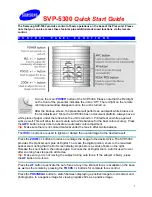
7.8 Digiscoping
223
f
Focus ref distance
. The distance of the virtual image projected by the
telescope lens and the subject distance to which the camera will focus.
500 mm is a good starting point.
After you have entered these values, you can review them in
Record mode
using the DOF browser (
ALT
+
LEFT
/
RIGHT
).
f
Scope mag
. The magnification of the scope.
f
Scope EP
. Diameter of the scope’s exit pupil in mm. This entry will be red
when it is the limiting aperture (smaller than the camera’s entrance
pupil).
f
Camera EP
. The diameter of the camera’s entrance pupil in mm. This
entry will be red when it is the limiting aperture (smaller than the
scope’s exit pupil).
f
EFL
. The combined focal length of camera and scope.
f
EFL (35mm)
. The 35mm-equivalent of EFL.
It’s a good idea to use focus bracketing in connection with digiscoping.
First, it increases the tolerance for focusing. Also, the series of images ob-
tained can be combined via focus stacking (section 4.6.3) in order to in-
crease the depth of field. With digiscoping, the DOF is notoriously small, so
focus stacking can make a lot of sense.
f
In the
Brackt/Override
submenu, set
Focus mode
to
Digiscop
. This will
cause bracketing around the preset
Focus ref distance
. The step size will
also depend on this value: the lower the
Focus ref distance,
the smaller
the focus step size.
f
Set
Tv bracket value
to
Off
.
f
Choose any value from 3 times to 19 times in entry
Bracketing type
.
f
Exit
<Alt>
mode and set the camera to
Continuous mode
or to
Custom
timer
(with an appropriate number of shots).
Of course, the scope must be mounted on a sturdy tripod. The camera must
be mounted on the same tripod, so you need some kind of a bracket (digi-
scoping adapter) on which both scope and camera can be mounted and
adjusted. The ideal adapter would allow swinging the camera quickly out
of place (for access to the ocular) and swinging it back again without com-
promising stability. Such adapters are not cheap—they may even cost more
than your camera. For the occasional shot, however, this low-cost and low-
tech version may be an alternative:
www.videojug.com/webvideo/how-tomake-a-digiscoping-adapter.
You also need to trigger the camera with the help of a USB remote
control. Because the
Digiscop
focusing mode switches the camera to FAST
mode, the camera will fire immediately when you press the switch instead
of waiting for switch release. If you don’t have a remote cable, you could
Figure 7-14
The DOF browser showing the
Digiscope Data
. The entry
Camera EP
is colored red, indicating that the
camera’s entrance pupil
(Camera EP)
is the limiting aperture. In the ideal
case, it will match the
Scope EP
.
Summary of Contents for Camera
Page 1: ......
Page 2: ...The Canon Camera Hackers Manual ...
Page 3: ......
Page 4: ...Berthold Daum The Canon Camera Hackers Manual Teach Your Camera New Tricks ...
Page 19: ...10 CH APTER 2 Cameras and Operating Systems ...
Page 25: ...16 CH APTER 3 ...
Page 85: ...76 CH APTER 4 Teach Your Camera New Tricks ...
Page 213: ...204 CH APTER 6 ...
Page 253: ...244 AP PENDIX ...
















































